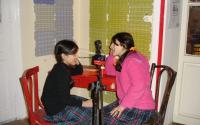30 March 2007Jerome Taylor
Thousands of harp seal pups are assumed dead in Canada's Gulf of St Lawrence due to the lack of ice floes, which mother seals require to nurse their pups successfully.
Experts with the International Fund for Animal Welfare (IFAW), who have been carrying out daily surveillance flights over the region, report that the Gulf of St Lawrence - the annual birthing ground for hundreds of thousands of harp seals - is devoid of both ice and seals. Their report came as Canada announced a seal cull quota of 270,000 - down 30,000 from last year. Canadian officials said that hunters will be allowed to kill a quarter fewer seals on the east coast this year mainly because of poor ice conditions where the animals give birth.
But campaigners in Charlottetown, on Canada's Prince Edward Island, expressed outrage that the cull was going ahead in the face of the devastating mortality rates of young seals. Sheryl Fink, senior researcher with IFAW's seal campaign, said: "In the nine years I have observed the seal hunt, I've never seen conditions as bad as those I've witnessed in the past few days. Nothing could have prepared me for this devastation." Ms Fink has spent the past two months flying over ice floes for up to three hours at a time, counting the seal population She said: "The seals' habitat is melting away and we are anticipating nearly 100 per cent mortality among more than 260,000 seal pups the Canadian government indicates were born this year in the southern Gulf of St Lawrence."
Yesterday Ms Fink spotted a couple of hundred adult seals over the northern Gulf near the Strait of Belle Isle, but no pups. The solid ice pack expected at this time of the year has been reduced, she said, to "tiny pans surrounded by areas of open water".
More than 250,000 pups were estimated to have been born in the southern Gulf of St Lawrence this year. But the ice they were living on was swept out of the Gulf and into the Atlantic Ocean earlier this month. As the ocean swells and high winds smash up the ice even more, the pups, who are too young to swim, are being forced into the water.
At a press conference in Ottowa yesterday, Canadian officials conceded there were poorer ice conditions than usual in the southern Gulf, but said it was only "one small piece of the overall hunt". Kevin Stringer, an environment ministry spokesman, said: "The decrease [in the seal cull quota] this year is very substantial... we think it's an important move and is sustainable." This is strongly contested by campaigners who complained that the Canadian government was also flying over the ice floes, conducting free surveys for the sealing industry to find the seal pups.
The hunt around the Magdalen Islands usually accounts for around 20 percent of the overall catch. Most seals are killed off the coast of Newfoundland, further to the north.
Rebecca Aldworth, of the Humane Society of the United States, said: "It's appalling... they're actually talking about allowing the hunt in the southern Gulf to proceed to wipe out the few remaining seal pups there."
Mr Stringer admitted that around 90 per cent of the pups born in the southern Gulf this year could die but said if this were the case, it would not necessarily have a big impact on overall seal herd health.
Ms Fink said: "With harp seals facing a growing threat from global warming and poor ice conditions, continuing the hunt at the unsustainable level announced today is nothing short of irresponsible."
http://news.independent.co.uk/environment/wildlife/article2405136.ece






